President's Message
Fellow woodworkers
Only recently I read in Fine Woodworking about the amazing gallery of American furniture at the Yale University American Decorative Arts Gallery.
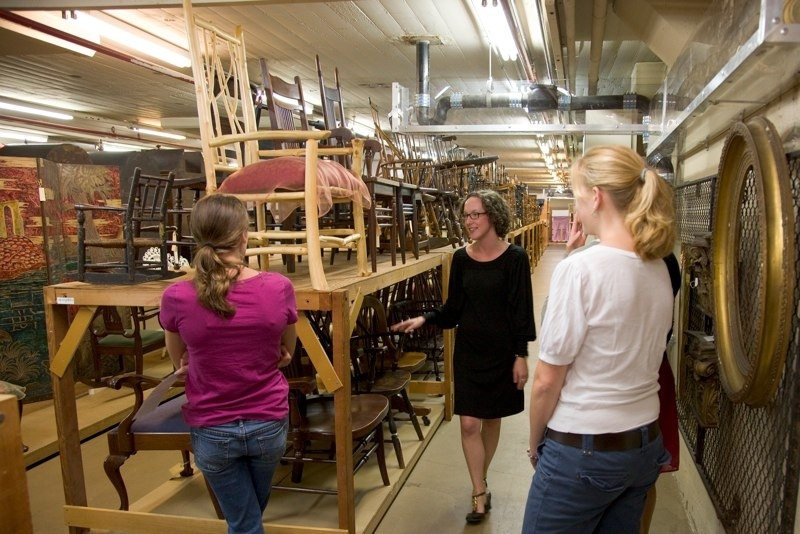
They have more than a 1000 pieces of furniture and wooden objects from 17th to 21st century.
It is setup as a place to study furniture with several free tours per week that are open to the general public (including woodworkers)
You can check their tour calendar at:calendar.yale.edu/cal/opa
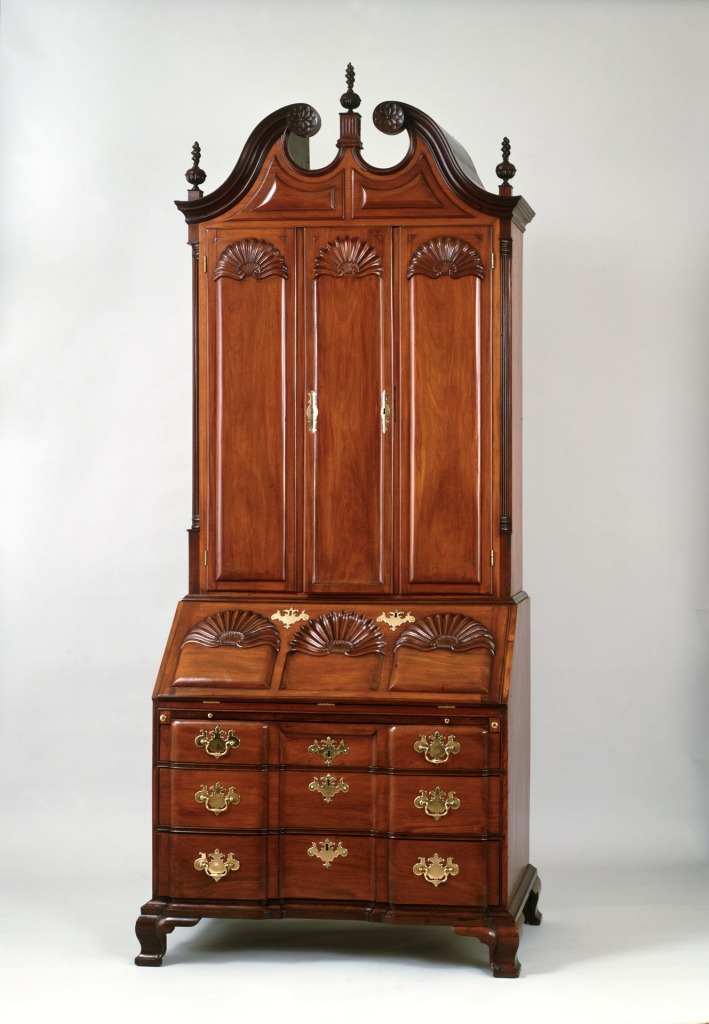
If you select one of the pieces of furniture they have on-line you can download a very high resolution file of the object and zoom into and examine all the fine detail. I downloaded a high resolution picture of this 18 century Desk and Bookcase.
If you are up to the task of making a copy of some nice desk then I think you can even make arrangements to go to the Gallery, ruler in hand, and measure the piece you want - would make a great Show and Tell presentation.
The Yale University Art Gallery has also developed a website, the Rhode Island Furniture Archive, as a resource for studying furniture making in Rhode Island from the 17th to the 19th century.
See more at: artgallery.yale.edu
In the Rhode Island section they have over 3700 items on-line and you can search by details such as maker, type, wood etc.
Rhode Island collection at: rifa.art.yale.edu
If you are in to old furniture this is the kind of database that can keep you occupied for months.
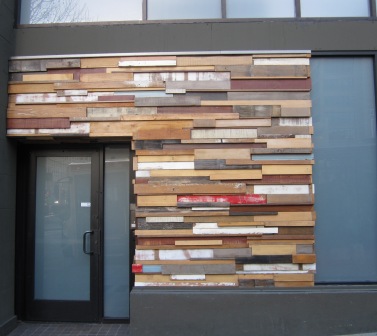
In July I published this picture as a reclaimed wood design that did not work. I said that the wood would be better if it was left to rot and never reclaimed

Well I take no credit for the improvement of the neighborhood but the company has now painted over the wood with basic gray - it looks a lot better.
Reminder: September meeting is our annual Box Making contest and October is the 2x4 contest
Enjoy your woodworking
Frank [Contact at: frankramsay8@aol.com
Frank Ramsay, well supported with his new neck brace, brought down the gavel to open the August meeting right on time. He announced that there had been a change of agenda for this evening's meeting due to a family health issue by our scheduled speaker, Heather Trosdahl. She will be invited to return at a later date. Instead of the planned agenda, Jay Perrine and Tom Gaston will present on lecture a shop safety and first aid. Their talk will be supplemented with short presentations from a few BAWA members on their current projects.
New Members and Guests:
Greg Burge, whom many of us know from Woodcraft in San Carlos, joined us as a guest this evening.
Ruth, who lives Belmont and learned woodworking from her father, also joined us as a guest tonight.
Announcements:
Per Madsen, just returned yesterday from Denmark, opened with announcements of the upcoming BAWA meetings. In September Lou Kern will talk about functional art and BAWA will hold its annual Box Contest. In October, John Kelly from UC Berkeley will join us and we will hold the 2 X 4 Contest. In November there will be a board meeting, the BAWA annual meeting with election of officers. No speaker has yet been scheduled.
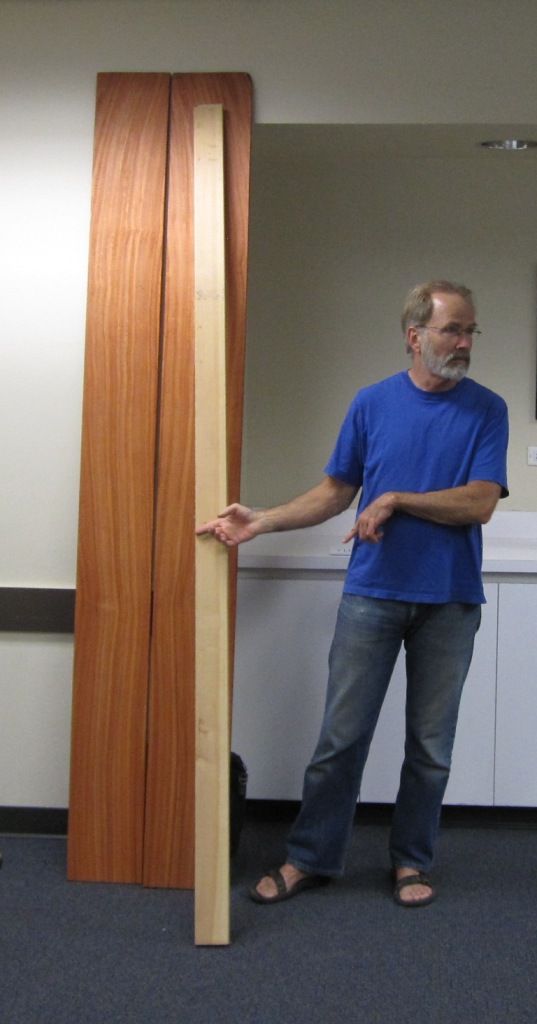
Jamie Buxton addressed the meeting and once again explained the complicated rules for the 2 X 4 contest: make something from just one 2 X 4 piece of lumber. That's it. Jamie donated a carefully selected and cherished Douglas Fir 2 X 4 from his personal stash, chosen green from Home Depot several months ago and now dry as a bone.
Stan Booker just returned from his Montana vacation and regaled us with a fish story: His guide, the proud owner of a 10mm semi-automatic pistol with laser sight and a 50 caliber rifle, took him fishing to a private lake 8000 feet high in the mountains seven miles along a dirt track that took two hours to traverse in a Land Cruiser. But once at the lake they caught an incredible number of fish: cut throats, rainbows and natives. Harold Patterson cringed when he learned they kept seven fish to eat and even used spinning gear, not the fly tackle of the purist. We were glad to hear the story, and even more pleased that the raffle and door prizes had returned. The raffle prize is two 1 x 12 boards of paduk.
Jim Voos who is relocating to Templeton in Central California, rose to thank the BAWA members for their friendship and assistance over the years. He has greatly enjoyed his associations and learned from his participation in the club. His new contact information can be obtained from the club secretary, John Blackmore.
Jay Perrine and Tom Gaston Cutting Edge First Aid
Jay and Tom adapted their presentation from a Fine Woodworking article published in the Tools and Shop issue in 2011.
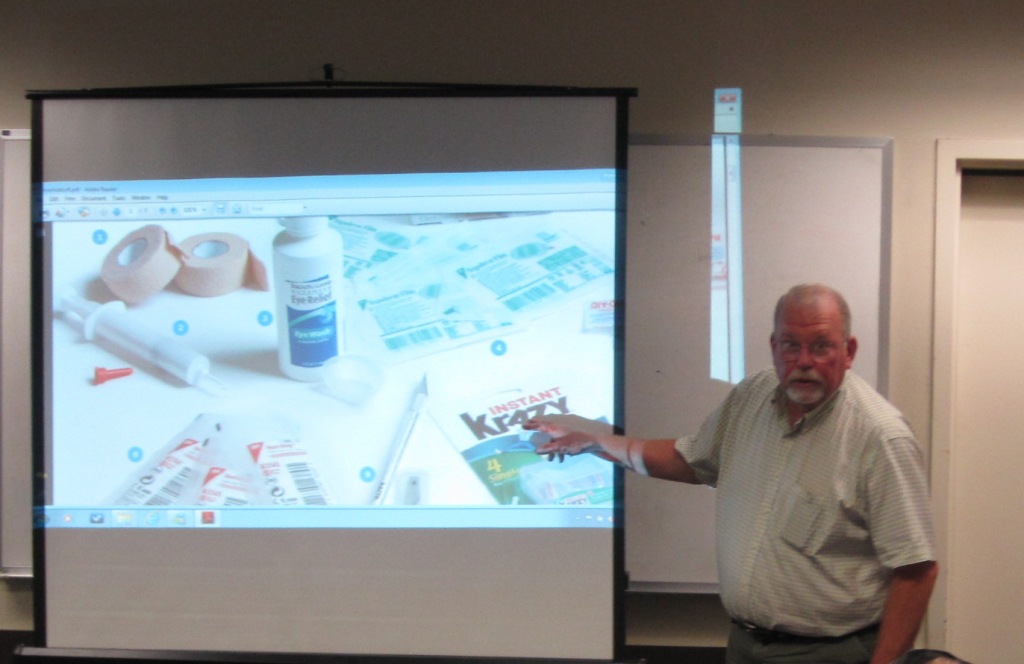
Jay showed us a first aid kit he had put together years ago for use in his shop. He recommended that it be thrown away and updated with new products and he turned the show over to Tom, who is a doctor, by the way.
The most common injuries, Tom explained, are minor ones that can be treated easily by the person who is injured. The good news about most wood shop injuries is that these wounds are usually caused by sharp tools resulting in clean cuts with smooth edges; edges that can be rejoined easily. If you cut yourself with a chisel for instance, the first thing to do is to apply pressure to the wound to stop the blood flow. You can stop the bleeding with pressure for 5 to 8 minutes. Then, clean the wound with soap and water. Once clean, approximate the edges of the wound together and tape the resealed wound shut tightly. Within 12 to 18 hours the wound will be well into the healing process. Once again, use common sense, apply pressure and be patient. The bleeding will stop after 5 to 8 minutes.
Puncture wounds are dirtier because the wound edges are rough and residue from the instrument causing the wound is usually left behind. Rusty nails, for instance, leave iron fragments in the wound that consume oxygen in the wound site. Oxygen kills bacteria so you want to keep it plentiful in the wound. Make sure your tetanus shot is up to date.
If you get something in your eye, lie down and wash your eye out with tap water. You can irrigate by dripping water off the bridge of your nose into the corner of your eye, or you can simply pool the water in the eye socket.
Some of the newer products include Tagaderm, a clear film bandage, NuSkin, an artificial skin sealant and Coban, a self-adherent elastic bandage. Cyanoacrylate glues also work well to seal wounds by placing strips of the cement perpendicular across the wound line. The less viscous glues do not work well.
If you are unfortunate and have a table saw injury, immediately apply pressure to stop the bleeding. Do not apply a tourniquet. Only a medical professional should apply this device. First take care of yourself: apply pressure, stop bleeding, and stay calm. Once the situation is stabilized, retrieve the severed fragment and bring it with you to the nearest emergency medical facility. Do not put the fragment on ice. Ice will burn and kill cellular tissue.
Remember, apply pressure, stay calm and be patient.
Arnold Champagne

Arnie is making a tea box for a young couple. The box has a thin, veneered top that presented a challenge when mounting the lid hinges. The Brusso hinges came with 3/4 in. screws that would have penetrated the lid, so Arnie had to use 3/8 in. screws. In cases like this for more secure placement he would like to see hinges with three holes instead of the typical two. The box has dovetailed corners and brass feet. The interior dividers are .125" thick, matching the width of his saw blade, making for snug divider fits.
Tom Gaston
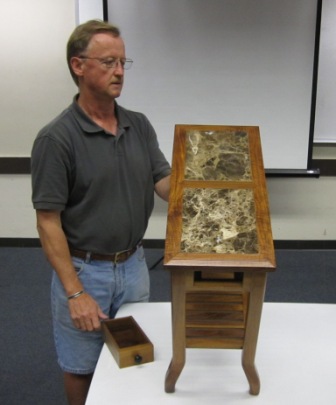
Tom made a walnut side table designed as a reading table. It has a marble stone top, polished to a lustrous sheen with progressively fine sandpapers. The center, dovetailed drawer is for storing reading glasses and pencils. Arnie checked the fit of the drawer and pronounced it a nice fit. He did, however, suggest some shimming strips to perfect the fit. Tom used Yeung Chan type miters to join the legs to the top and tenons for joining the bottom tray.
Ray Burger
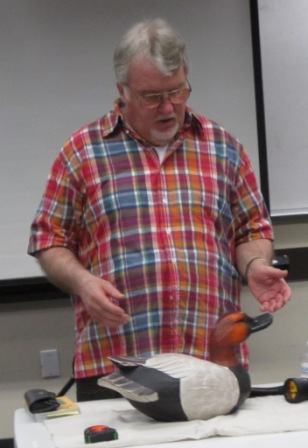
Ray brought in a wooden duck made by Paul Venier, a farmer in Northern California, who makes ducks in his spare time during the winter months. The ducks are made in three styles: Merganser, Mallard and Redhead. The body is carved separate from the head then joined to complete the sculpture. The wood used to carve the ducks is postulated to be either basswood or a soft pine. Ray bought his Redhead duck, measuring 8" wide by 16" long and 6" high at the shoulder for $45 ten years ago. Today, similar ducks sell for over $700.
Ken Napior
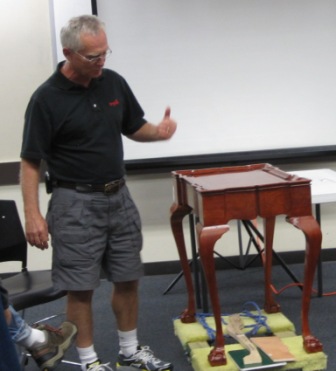
Ken made a replica of a John Goddard cherry table, the original made in 1750 having sold in Newport Rhode Island recently for $8.3 million. Ken politely declined to take offers for his table during the meeting. His replica is distinguished by having added four concealed drawers under the tabletop and inside the table apron. The table apron was made from a single piece of cherry, cut into four pieces and rejoined at the corners matching the grain at all but the fourth corner. Cabriolet legs were modified from the original to fit behind the table apron, and included carved ball and claw feet. Ken estimates that each leg took 5 hours to make. He spent a total of 45 hours to make the table. The cherry was dyed to impart a consistent color throughout the table. When asked, Ken said he would be happy to demonstrate his technique for making the ball and claw feet during a future Show & Tell event.
John Blackmore
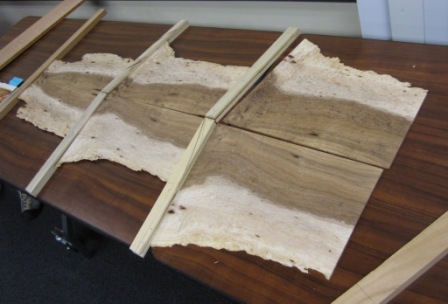
The wood
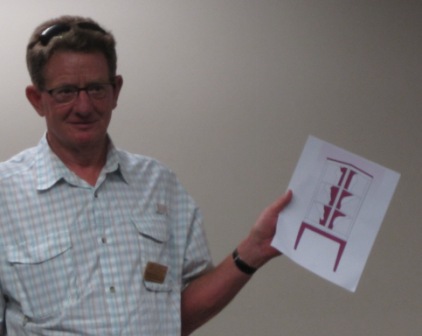
The plan
John had mocked up the two front doors for a Krenov style cabinet he plans to make in the near future. The two glass doors will each feature three sequenced book-matched panels of acacia that John cut from an 18" round salvaged from a tree removal service. The acacia panels have natural outer edges and will match grain where the doors meet in the center of the cabinet. A Sketch Up drawing illustrated the planned cabinet.
And the meeting drew to a close, showing once again that BAWA members respond well to a challenge. Welcome back Frank, we're glad you are one tough coot.John Blackmore, Secretary
JohnBlackmore@comcast.net